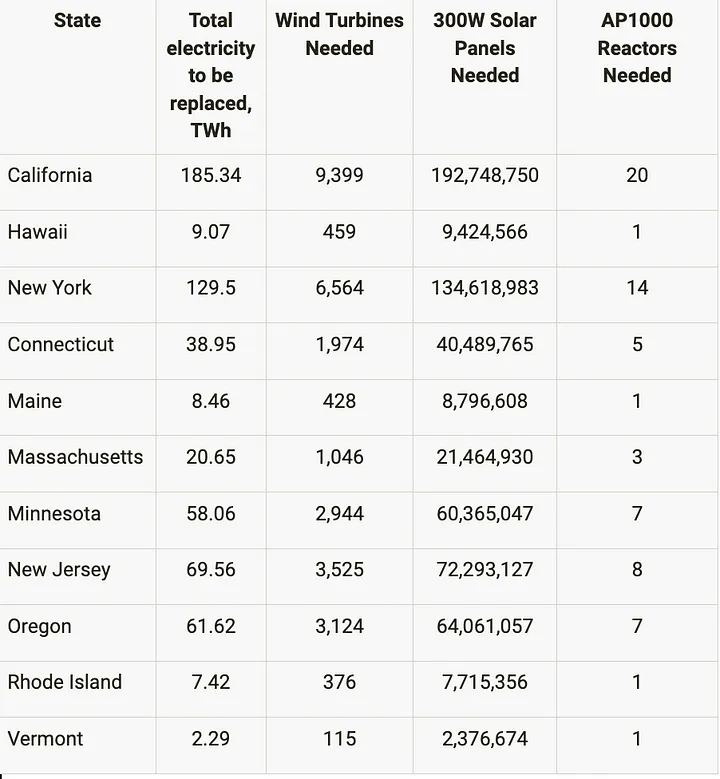Author: Madison Schroder

Eleven U.S. states across the country have adopted aggressive greenhouse gas reduction targets and pledged to combat climate change. But there’s a catch — these same states also have longstanding “nuclear moratoriums” that ban the expansion of nuclear power, one of the biggest sources of low-carbon electricity available.
These bans originated decades ago out of fears over nuclear plant accidents, radioactive waste, and radiation exposure. However, the moratoriums now severely restrict these states’ abilities to curb emissions and meet their own climate goals.
The 11 states with nuclear moratoriums currently in place are:
- California
- Hawaii
- New York
- Connecticut
- Maine
- Massachusetts
- Minnesota
- New Jersey
- Oregon
- Rhode Island
- Vermont
The nature of the moratoriums varies. Some states like Minnesota and Oregon have outright blanket bans on new plants. Others require statewide voter approval (Maine, Massachusetts, Vermont) or state legislative approval (Hawaii, Rhode Island) to overturn the building restrictions. And states like New York, California, and New Jersey have tied their moratoriums to progress on the federal level in resolving nuclear waste and fuel reprocessing issues.
The restrictions mean these states cannot expand their existing nuclear generation capacity, although plants already up and running continue to provide steady volumes of clean electricity. The bans aren’t necessarily permanent either. For example, Connecticut recently opened the door to potential new nuclear at the Millstone station, while also keeping the moratorium in place generally.
In the past, the list of states with nuclear moratoriums on the books was longer. But in recent years, five states — Illinois, West Virginia, Montana, Kentucky, and Wisconsin — chose to lift their bans specifically to enable nuclear growth as part of their overall push towards clean electricity.
So how do you meet a climate change target like net-zero emissions by 2050 without the ability to use nuclear power? What would it look like if these states lifted their moratorium and used new nuclear power?
To demonstrate the clean energy challenge these states face, I’ve done a simple electricity replacement analysis. The goal is to determine how much wind, solar, or nuclear capacity each state would need to completely replace current fossil fuel generation with zero-carbon sources.
For simplicity, I assumed a 50/50 split between wind and solar for renewables. The calculations use real-world average capacity factors — 41% for wind turbines and 25% for solar panels — to account for intermittency. On the nuclear side, I analyzed the deployment of Westinghouse’s latest design, the AP1000 reactor. I also used the Fossil to Nuclear calculator on the Generation Atomic website for some help with the calculations.
The reason for looking at full replacement of fossil generation is that deep decarbonization by mid-century will require transitioning virtually the entire power fleet to clean sources.
With these assumptions laid out, let’s compare scaled-up wind, solar, and nuclear deployments in moratorium states wanting to eliminate carbon emissions from their electricity mix.

The vast difference in infrastructure scale and footprint makes it clear why having nuclear power available is so important. Constructing so many turbines and solar farms is likely impractical due to immense costs and land requirements. Modern compact nuclear plants offer huge capacity in a relatively tiny space by comparison.
Keep in mind this quick exercise doesn’t even consider major grid reliability factors like seasonal production changes and intermittency challenges from renewables.
The takeaway is that while an optimal clean electricity mix certainly incorporates renewables and nuclear generation, banning nuclear means states have to compensate with a massive overbuild of wind and solar to displace fossil fuels. These states are fighting the critical climate change battle with their hands tied by longstanding nuclear fear and resistance.
Given what’s at stake environmentally and the short timeline to net-zero emissions, states need to reassess whether upholding decades-old nuclear moratoriums still makes sense. Allowing this proven mega-scale zero-carbon power source to contribute enables a much more viable path to a successful clean energy transition.
Watch my TikTok on this topic HERE


